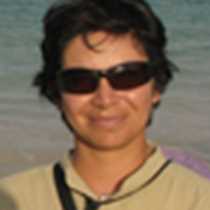Santa Cruz Island
We arrived this morning to Academy Bay, Santa Cruz Island. This is the second largest island in the Galápagos and as the most populated, it holds the main quarters of the Charles Darwin Research Center and the National Park Service offices. The morning was dedicated to visit the rearing center and to learn about the restoration programs for Galápagos giant tortoises, land iguanas and the prickly pear cactus unique to the island of Española.
We lucked out with the weather and it turned into a bright and sunny morning, therefore it was warm enough for the giant tortoises to remain actively feeding and walking in their corrals. We had a great chance to see the different varieties of giant tortoises and their diverse shell shapes. There are three main types: dome shape, saddle back and the “intermediate” variety. Fortunately we got to see all of those different types as we walked along the boardwalk path in the station.
This area has also a great variety of plant life unique from the region, which gave us the chance to observe many different birds and their nests, especially the famous Darwin finches.
After our visit to the tortoises and the rearing center we headed to the main streets of Puerto Ayora, exploring fully this little, charming town and its shops.
After a well deserved lunch up in the highlands we began our exploration when driving even further into the forest looking for the giant tortoises' reserve. Once we arrived, we found several tortoises resting, feeding, and wallowing in the few mud holes left from a small water pond which has almost dried out.
Later on, as we arrived to the lush and green scalesia (giant daisy) zone, we observed how intricate the ecosystem is here. Lots of ferns and epiphytes were covering the entire surroundings, giving the perfect wrap to one of the most amazing geological formations found in this area: “The Pit Craters”. These huge caldera-like formations are now covered by trees, grasses and are nothing else but the remnants of the frequent past volcanic activity that Santa Cruz Island used to have.
During our walk through the scalesia forest we were closely inspected by a male Vermillion fly catcher. Apparently we were in his territory, and it wanted to have a better look at us humans.
We left the Scalesia forest behind and drove back to Puerto Ayora in the late afternoon; we were very happy to have fulfilled our day with many exciting highlights!
We arrived this morning to Academy Bay, Santa Cruz Island. This is the second largest island in the Galápagos and as the most populated, it holds the main quarters of the Charles Darwin Research Center and the National Park Service offices. The morning was dedicated to visit the rearing center and to learn about the restoration programs for Galápagos giant tortoises, land iguanas and the prickly pear cactus unique to the island of Española.
We lucked out with the weather and it turned into a bright and sunny morning, therefore it was warm enough for the giant tortoises to remain actively feeding and walking in their corrals. We had a great chance to see the different varieties of giant tortoises and their diverse shell shapes. There are three main types: dome shape, saddle back and the “intermediate” variety. Fortunately we got to see all of those different types as we walked along the boardwalk path in the station.
This area has also a great variety of plant life unique from the region, which gave us the chance to observe many different birds and their nests, especially the famous Darwin finches.
After our visit to the tortoises and the rearing center we headed to the main streets of Puerto Ayora, exploring fully this little, charming town and its shops.
After a well deserved lunch up in the highlands we began our exploration when driving even further into the forest looking for the giant tortoises' reserve. Once we arrived, we found several tortoises resting, feeding, and wallowing in the few mud holes left from a small water pond which has almost dried out.
Later on, as we arrived to the lush and green scalesia (giant daisy) zone, we observed how intricate the ecosystem is here. Lots of ferns and epiphytes were covering the entire surroundings, giving the perfect wrap to one of the most amazing geological formations found in this area: “The Pit Craters”. These huge caldera-like formations are now covered by trees, grasses and are nothing else but the remnants of the frequent past volcanic activity that Santa Cruz Island used to have.
During our walk through the scalesia forest we were closely inspected by a male Vermillion fly catcher. Apparently we were in his territory, and it wanted to have a better look at us humans.
We left the Scalesia forest behind and drove back to Puerto Ayora in the late afternoon; we were very happy to have fulfilled our day with many exciting highlights!



